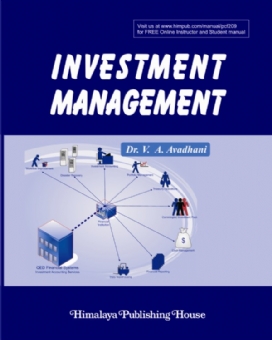The theory and principles of Investment Management remain unaltered but the backdrop of the operations of investment and the practices and procedures of investment management change from time to time. The financial markets in which most of the operations take place are a reflection of the economy and its performance. The economic and financial reforms in India are a continuing process and these affect the operations in the financial markets. The changes are to be incorporated in any revision of a book of this nature, which is being used by students of finance whether in MBA or M.com. or any other professional course. This is the rationale of the present revision, which hopefully helps the student update the information relevant to the area.
Contents :
PART I : INVESTMENT SETTING
1. Securities Markets
2. Savings and Investment
3. Macro aspects of Savings and Investments
4. Financial System − Intermediation
5. Investment Avenues
6. Features of Investment Avenues
7. Tax Planning for Investment
PART II : MONEY AND CAPITAL MARKETS AND INSTITUTIONS
8. Overview of Capital Market
9. Institutional Structure in Capital Market
10. Capital Market Reforms
11. New Issues Market and Problems
12. Money Market and its Instruments
13. The Securities and Exchange Board of India (SEBI)
PART III : SECONDARY MARKETS IN INDIA
14. Securities Trading Regulations
15. Instruments of Issue and Trading
16. Stock Markets in India
17. OTCEI, NSE and ICSE
18. Stock Market Operations and Functions
19. Trading in the Stock Market
PART IV : SECURITY ANALYSIS
20. Sources of Investment Information
21. Inflation and Investments
22. Security Market Analysis
23. Investment Decision Making
24. Financial Analysis and Interpretation
25. Balance Sheet Analysis and Blue Chips
26. Fundamental Analysis
27. Technical Analysis of the Market
28. Efficient Market Theory
PART V : RISK AND RETURN CONCEPTS AND MEASUREMENT
29. Risk and Credit Rating
30. Security Market Indicators
31. Interest rates − Theory and Structure
PART VI : VALUATION OF STOCKS AND BONDS
32. Financial Arithmetic’s
33. Security Pricing
34. Investment Analysis and Theory
35. Valuation of Bonds − Bond Market
36. Valuation of Contingent Claims and Options
PART VII : PORTFOLIO THEORY AND MANAGEMENT
37. Risk and Return in Portfolio Management
38. Capital Asset Pricing Model (CAPM)
39. Portfolio Analysis
40. Diversification and Techniques of Risk Reduction
41. Markowitz Model
42. Basics of Portfolio Management in India
43. Modern Portfolio Theory
44. Portfolio Management: Construction Revision and Evaluation
45. Mutual Funds and Their Schemes
46. Disinvestment Management
47. Securities Market Report (BSE)







